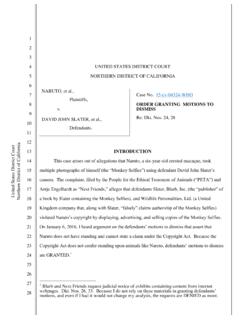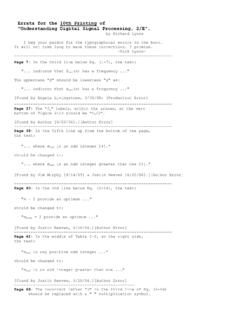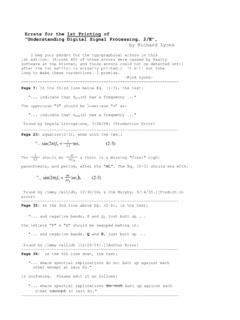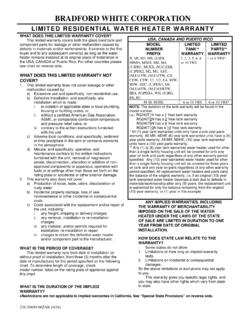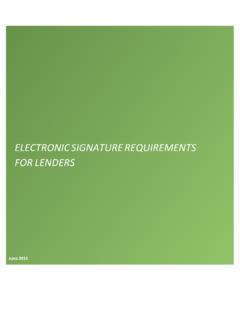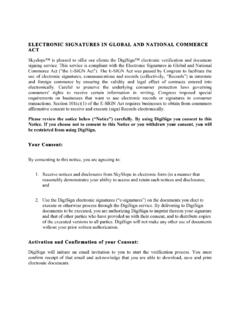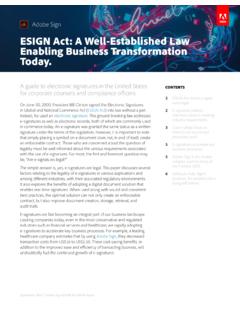Transcription of USE OF ELECTRONIC SIGNATURES IN FEDERAL …
1 USE OF ELECTRONIC SIGNATURES . IN FEDERAL organization transactions . Version January 25, 2013. Use of ELECTRONIC SIGNATURES in FEDERAL organization transactions Executive Summary This document was developed by the General Services Administration (GSA). and FEDERAL Chief Information Officers (CIO) Council at the request of the Office of Management and Budget (OMB). In developing this document, GSA collaborated with the Department of Defense (DoD), Department of Justice (DOJ), and the National Institute of Standards and Technology (NIST). This document supplements guidance previously issued by OMB and DOJ and referenced in Appendix H of this document. OMB is responsible for developing general standards and guidelines for the use of ELECTRONIC SIGNATURES by FEDERAL organizations, subject to any special requirements adopted by regulations issued by specific FEDERAL organizations. This document focuses on the ELECTRONIC signature requirements of the Government Paperwork Elimination Act of 1998 (GPEA), the ELECTRONIC Records and SIGNATURES in Global and National Commerce Act (E-SIGN), and the Uniform ELECTRONIC transactions Act (UETA), and is designed to assist FEDERAL organization officials in complying with the signing requirements of these statutes applicable to ELECTRONIC transactions .
2 While this document provides general guidance with respect to compliance with the legal requirements for ELECTRONIC SIGNATURES , it is unable to address all of the legal issues that might arise. Thus, FEDERAL organizations should consult with their legal counsel as necessary when questions arise regarding implementation of the guidance provided here, or with respect to other ELECTRONIC signature issues not addressed here. This guidance has been prepared for use by FEDERAL organizations. It may also be used by nongovernmental organizations on a voluntary basis and is not subject to copyright. Nothing in this document should be taken to contradict standards and guidance made mandatory and binding by specific regulations adopted by any FEDERAL organization . Nor should this guidance be interpreted as altering or superseding the existing authorities of any FEDERAL organization with respect to signature issues. i Use of ELECTRONIC SIGNATURES in FEDERAL organization transactions TABLE OF CONTENTS.
3 A. INTRODUCTION AND SCOPE .. 1. B. OVERVIEW OF THE LAW OF ELECTRONIC SIGNATURES .. 2. 1. The Role of SIGNATURES Generally .. 2. 2. The Law Governing ELECTRONIC SIGNATURES .. 3. 3. Legal Approach to ELECTRONIC SIGNATURES .. 4. (a) Functional Equivalence .. 5. (b) Technology Neutrality .. 5. 4. ELECTRONIC SIGNATURES Compared to Digital SIGNATURES .. 5. 5. Relationship between an ELECTRONIC signature , a Security Procedure, and a Signing Process .. 7. 6. Impact of Enabling Automatic Digital Signing with PIN Caching .. 9. C. DETERMINING WHETHER AN ELECTRONIC signature IS 12. 1. Legal Requirement for a signature .. 12. 2. Transaction-Based Need for a signature .. 12. D. REQUIREMENTS FOR LEGALLY BINDING ELECTRONIC SIGNATURES .. 14. 1. ELECTRONIC Form of signature .. 16. 2. Intent to Sign .. 18. 3. Association of signature to the Record .. 21. 4. Identification and Authentication of the Signer .. 24. 5. Integrity of Signed Record .. 26. E. SATISFYING THE SIGNING REQUIREMENTS.
4 28. 1. Overall 28. 2. Risk Analysis .. 29. (a) Evaluating Likelihood of Successful Challenge to signature .. 30. (b) Evaluating Extent of Resulting Loss or Adverse 33. 3. Overall Risk Level Determination .. 35. 4. Acting on the Risk Assessment Results .. 35. (a) ELECTRONIC Form of signature .. 36. (b) Intent to Sign .. 36. (c) Association of signature to Record .. 37. (d) Identification and Authentication of Signer .. 37. (e) Integrity of Signed Record .. 38. 5. Evaluating Risk-Based Options: Cost - Benefit Analysis Factors .. 41. (a) Technology Issues .. 42. (b) Requirements of the Signing Process .. 43. (c) Capabilities of the Signing Party .. 43. (d) Cost of Implementing / Using the Signing Process .. 43. 6. Special Rule for Intra-Governmental transactions .. 43. F. GLOSSARY .. 44. ii Use of ELECTRONIC SIGNATURES in FEDERAL organization transactions G. STATUTES .. 50. H. REFERENCES .. 50. TABLES. Table C-1 Determining Whether an ESignature is 13. Table E-1 Risk Level Determination.
5 35. Table E-2 Satisfying the signature Requirements .. 39. FIGURES. Figure D-1 Requirements for Legally Binding ELECTRONIC SIGNATURES .. 15. iii Use of ELECTRONIC SIGNATURES in FEDERAL organization transactions USE OF ELECTRONIC SIGNATURES . IN FEDERAL organization transactions . A. INTRODUCTION AND SCOPE. This document provides general guidance for FEDERAL organizations regarding the use of ELECTRONIC SIGNATURES in connection with ELECTRONIC records and ELECTRONIC transactions . It addresses the following basic questions: When should a FEDERAL organization use an ELECTRONIC signature ? What are the requirements for creating a legally binding ELECTRONIC signature in ELECTRONIC transactions ? What factors should FEDERAL organizations consider when deciding which signing process to use? The focus of this guidance is on the use of ELECTRONIC SIGNATURES for legal signing purposes in the context of ELECTRONIC transactions . Because this guidance focuses on ELECTRONIC SIGNATURES used for legal signing purposes in ELECTRONIC transactions , it does not address the use of similar ELECTRONIC processes solely for social, identification, technical, or security-related purposes (such as authentication or document integrity).
6 Thus, when symbols or processes that can qualify as a legally binding ELECTRONIC signature (if the requirements set out in Part D. below are met) are used in a manner that is not intended to be a legally binding signature ( , intended merely to convey a social message, to identify the sender, or to provide some level of security) they are not covered by this guidance. Likewise, this guidance focuses only on the use of legally binding ELECTRONIC SIGNATURES in the context of ELECTRONIC transactions , actions between two or more persons relating to the conduct of business, consumer, commercial, or governmental It does not address the use of SIGNATURES or similar ELECTRONIC processes in communications that do not constitute an ELECTRONIC transaction, such as their use in a more informal setting like a social email. Moreover, this guidance does not address any of the other requirements for a valid ELECTRONIC transaction, such as requirements for the consent of the parties to conduct the transaction in ELECTRONIC form or to receive documents in ELECTRONIC form, requirements for contract formation processes, ensuring the ability to download and print, Also, this document does not address any specific privacy issues that may 1.
7 See generally E-SIGN, 15 7006(13) and UETA 2(16) (definitions of transaction ). 2. For guidance regarding some of those issues, see generally, Office of Management and Budget Memorandum M-00-10, Implementation of the Government Paperwork Elimination Act, April 25, 2000. (hereinafter OMB M-00-10); Appendix II to OMB Circular A-130, November 2000; Office of Management and Budget Memorandum M-00-15, Guidance on Implementation of the ELECTRONIC SIGNATURES in Global and National Commerce Act (E-SIGN), September 25, 2000 (hereinafter OMB M-00-15 ); 1. Use of ELECTRONIC SIGNATURES in FEDERAL organization transactions arise in connection with the use of ELECTRONIC SIGNATURES . Individuals using this guidance should consult with their respective privacy offices and privacy counsel about any privacy issues. This guidance is designed to assist FEDERAL organization officials in complying with the signing requirements of the primary statutes applicable to ELECTRONIC transactions .
8 It does not, however, address the question of determining which one of those statutes applies to any particular agency ELECTRONIC transaction. Likewise, it does not address agency regulations that might impose additional signature requirements for particular types of ELECTRONIC transactions . This document also does not address the use of ELECTRONIC SIGNATURES (or other ELECTRONIC mechanisms) in the legislative While this document provides general guidance with respect to compliance with the legal requirements for ELECTRONIC SIGNATURES , it is unable to address all of the legal issues that might arise. Thus, FEDERAL organizations should consult with their legal counsel as necessary when questions arise regarding implementation of the guidance provided here, or with respect to other ELECTRONIC signature issues not addressed here. B. OVERVIEW OF THE LAW OF ELECTRONIC SIGNATURES . 1. The Role of SIGNATURES Generally A signature , whether ELECTRONIC or on paper, is the means by which a person indicates an intent to associate himself with a document in a manner that has legal significance ( , to adopt or approve a specific statement regarding, or reason for signing, a document).
9 It constitutes legally-binding evidence of the signer's intention with regard to a document. The reasons for signing a document will vary with the transaction, and in most cases can be determined only by examining the context in which the signature was made. Generally, however, a person's reason for signing a document falls into one of the following categories: Approving, assenting to, or agreeing to the information in the document or record signed ( , agreeing to the terms of a contract or inter-agency memorandum);4. Department of Justice, Legal Considerations in Designing and Implementing ELECTRONIC Processes: A. Guide for FEDERAL Agencies, November 2000. 3. Cf. Memorandum for the Counsel to the President from Jonathan G. Cedarbaum, Deputy Assistant Attorney General, Office of Legal Counsel, Re: Whether Bills May Be Presented by Congress and Returned by the President by ELECTRONIC Means (May 3, 2011); Memorandum Opinion for the Counsel to the President from Howard G.
10 Nielson, Jr., Deputy Assistant Attorney General, Office of Legal Counsel, Re: Whether the President May Sign a Bill by Directing that His signature Be Affixed to It (July 7, 2005). 4. With respect to contracts, for example, many courts note that: The purpose of a signature on a contract is to show mutual assent .. See, , Southern Elec. Servs. v. Cornerstone Det. Prods., 2010 Dist. LEXIS 54313, *13 ( Va. June 3, 2010); NeighborCare Pharm. Servs. v. Sunrise Healthcare Ctr., Inc., 2005 Dist. LEXIS 34404, *6 (D. Md. December 20, 2005); Taylor v. First N. Am. Nat'l Bank, 325 F. Supp. 2d 1304, 1313; 2004 Dist. LEXIS 13671, ( Ala. July 16, 2004); 17A Am. Jur. 2d Contracts 34. 2. Use of ELECTRONIC SIGNATURES in FEDERAL organization transactions Certifying or affirming the accuracy of the information stated in the document or record signed ( , certifying that the statements in one's tax return are true and correct);. Acknowledging access to or receipt of information set forth in the document or record signed ( , acknowledging receipt of a disclosure document).



